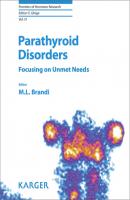Parathyroid Disorders. Группа авторов
Чтение книги онлайн.

Читать онлайн книгу Parathyroid Disorders - Группа авторов страница 10
Название: Parathyroid Disorders
Автор: Группа авторов
Издательство: Ingram
Жанр: Биология
Серия: Frontiers of Hormone Research
isbn: 9783318064094
isbn:
Asymptomatic PHPT is the most common presentation of PHPT seen in Europe and North America, and an increasingly common presentation in other parts of the world. Diagnosis depends on classical biochemical changes including increased serum calcium and PTH levels, with normal renal function and vitamin D sufficiency, and lack of symptoms related to the disorder. Some patients may have hypercalciuria, calcium-containing kidney stones, or osteoporosis, but not yet be symptomatic. The most recent guidelines recommend imaging for kidney stones or nephrocalcinosis, bone density testing of the lumbar spine, hips, and nondominant 1/3 distal radius, and measurement of 24-h urine calcium and creatinine to look for complications of the disorder in otherwise asymptomatic patients. As many as 25% of asymptomatic patients may develop indications for parathyroidectomy when followed over up to 15 years. Patients who remain asymptomatic should be monitored periodically for the development of complications that would justify surgery. Patients who become symptomatic should have surgery when recognized. Recent studies suggest that surgery may improve quality of life even in patients who remain asymptomatic. Medical options for therapy in patients with PHPT who cannot have or decline surgery are limited, with cinacalcet the only approved therapy at present.
References
1Khan AA, Hanley DA, Rizzoli R, Bollerslev J, Young JE, Rejnmark L, et al: Primary hyperparathyroidism: review and recommendations on evaluation, diagnosis, and management. A Canadian and international consensus. Osteoporos Int 2017;28:1–19.
2Callender GG, Udelsman R: Surgery for primary hyperparathyroidism. Cancer 2014;120:3602–3216.
3Fraser WD: Hyperparathyroidism. Lancet 2009;374:145–158.
4Clarke BL, Brown EM, Collins MT, Jüppner H, Lakatos P, Levine MA, Mannstadt MM, Bilezikian JP, Romanischen AF, Thakker RV: Epidemiology and diagnosis of hypoparathyroidism. J Clin Endocrinol Metab 2016;101:2284–2299.
5Wermers RA, Khosla S, Atkinson EJ, et al: The rise and fall of primary hyperparathyroidism: a population-based study in Rochester, Minnesota 1965–1992. Ann Int Med 1997;126:433–440.
6Silverberg SJ: Primary hyperparathyroidism; in Rosen CJ (ed): Primer on the Metabolic Bone Diseases and Disorders of Mineral Metabolism, ed 8. Washington, American Society for Bone and Mineral Research, 2013, pp 543–552.
7Griebeler ML, Kearns AE, Ryu E, Hathcock MA, Melton LJ 3rd, Wermers RA: Secular trends in the incidence of primary hyperparathyroidism over five decades (1965–2010). Bone 2015;73:1–7.
8Yeh MW, Ituarte PH, Zhou HC, Nishimoto S, Liu IL, Harari A, Haigh PI, Adams AL: Incidence and prevalence of primary hyperparathyroidism in a racially mixed population. J Clin Endocrinol Metab 2013;98:1122–1129.
9Yu N, Donnan PT, Murphy MJ, Leese GP: Epidemiology of primary hyperparathyroidism in Tayside, Scotland, UK. Clin Endocrinol 2009;71:485–493.
10Walker MD, Silverberg SJ: Primary hyperparathyroidism. Nat Rev Endocrinol 2018;14:115–125.
11Bilezikian JP, Bandeira L, Khan A, Cusano NE: Hyperparathyroidism. Lancet 2018;391:168–178.
12Marcocci C, Cetani F, Rubin MR, et al: Parathyroid carcinoma. J Bone Miner Res 2008;23:1869–1880.
13Li Y, Simonds WF: Endocrine neoplasms in familial syndromes of hyperparathyroidism. Endocr Relat Cancer 2015;23:R229–R247.
14Tezelman S, Rodriguez JM, Shen W, Siperstein AE, Duh QY, Clark OH: Primary hyperparathyroidism in patients who have received radiation therapy and in patients who have not received radiation therapy. J Am Coll Surg 1995;180:81–87.
15Sharretts JM, Simonds WF: Clinical and molecular genetics of parathyroid neoplasms. Best Pract Res Clin Endocrinol Metab 2010;24:491–502.
16Silverberg SJ, Clarke BL, Peacock M, Bandeira F, Boutroy S, Cusano NE, Dempster D, Lewiecki EM, Liu JM, Minisola S, Rejnmark L, Silva BC, Walker MD, Bilezikian JP: Current issues in the presentation of asymptomatic primary hyperparathyroidism: proceedings of the Fourth International Workshop. J Clin Endocrinol Metab 2014;99:3580–3594.
17Cusano NE, Maalouf NM, Wang PY, Zhang C, Cremers SC, Haney EM, Bauer DC, Orwoll ES, Bilezikian JP: Normocalcemic hyperparathyroidism and hypoparathyroidism in two community-based nonreferral populations. J Clin Endocrinol Metab 2013;98:2734–2741.
18Eastell R, Brandi ML, Costa AG, D’Amour P, Shoback DM, Thakker RV: Diagnosis of asymptomatic primary hyperparathyroidism: proceedings of the Fourth International Workshop. J Clin Endocrinol Metab 2014;99:3570–3579.
19Zanocco KA, Yeh MW: Primary hyperparathyroidism: effects on bone health. Endocrinol Metab Clin North Am 2017;46:87–104.
20Cipriani C, Biamonte F, Costa AG, Zhang C, Biondi P, Diacinti D, Pepe J, Piemonte S, Scillitani A, Minisola S, Bilezikian JP: Prevalence of kidney stones and vertebral fractures in primary hyperparathyroidism using imaging technology. J Clin Endocrinol Metab 2015;100:1309–1315.
21Castellano E, Attanasio R, Gianotti L, Cesario F, Tassone F, Borretta G: Forearm DXA increases the rate of patients with asymptomatic primary hyperparathyroidism meeting surgical criteria. J Clin Endocrinol Metab 2016;101:2728–2732.
22Vestergaard P: Primary hyperparathyroidism and nephrolithiasis. Ann Endocrinol 2015;76:116–119.
23Marchini GS, Faria KVM, Torricelli FCM, Monga M, Srougi M, Nahas WC, Mazzucchi E: Sporadic primary hyperparathyroidism and stone disease: a comprehensive metabolic evaluation before and after parathyroidectomy. BJU Int 2018;121:281–288.
24Walker MD, McMahon DJ, Inabnet WB, et al: Neuropsychological factors in primary hyperparathyroidism: a prospective study. J Clin Endocrinol Metab 2009;94:1951–1958.
25Bilezikian JP, Khan A, Potts JT Jr, Brandi ML, Clarke BL, Shoback D, Jüppner H, D’Amour P, Fox J, Rejnmark L, Mosekilde L, Rubin MR, Dempster D, Gafni R, Collins MT, Sliney J, Sanders J: Hypoparathyroidism in the adult: epidemiology, diagnosis, pathophysiology, СКАЧАТЬ